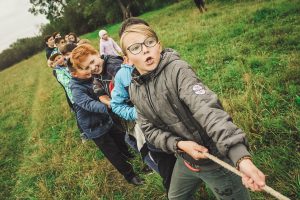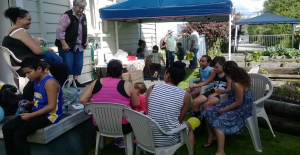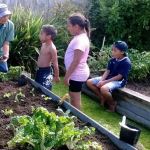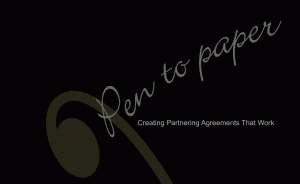The Working Together Continuum
Understanding different kinds of working relationships is crucial to getting the most out of key stakeholders within your community. From local government, to businesses, to residents, to funders and everyone in between, having an understanding of the types of working relationships you’re likely to encounter – and which ones you will strive to have – will only strengthen your ability to connect with people community-wide.
This explanatory document will introduce you to the types of relationships and their characteristics and allow you to constructively plan ways of communicating and bringing people together to work within these relationship types. It might also encourage you to move a working relationship along the continuum, because it’s important to note that partnering isn’t necessarily the ultimate goal for every relationship.
Also, this worksheet may be useful to print and use in mapping out current and intended relationships.
Questioning our Leadership Assumptions
What words or images immediately come to mind when you think about leadership?
Strong? Decisive? Heroic? Visionary? Charismatic? Great communicators? Courageous?
We can quickly end up with a super-human job description for leaders that then feels out of reach for most of us. Yet for each of the words or images you identified about leadership and leaders’ qualities, skills, behaviours and attitudes, the opposite is also likely to be true.
For example, it’s great when those in leadership roles can:
- have a strong sense of self and show and cope with being vulnerable too
- offer decisive answers and also know when it is better to ask powerful questions to help a group find answers together
- inspire people with their own vision and be a good facilitator, helping everyone’s voice to be heard in shaping a shared vision
- lead out front at times and be quiet nurturers of others, leading by walking alongside or behind, at other times
- be great communicators and great listeners
- be courageous in their actions and humble in their reflections
- help put plans, structures and systems in place and be comfortable working in situations that call for more organic, messy, one-step-at-a-time approaches.
So we can relax about what we expect leaders to know or be or do! From a CLD perspective, our aim is to grow a “leaderful” community, where people keep moving between different leadership roles depending on the situation. There are many different ways of ‘doing’ leadership. And the best leaders keep adapting their responses, based on what they are noticing is happening in the community around them.
Some final questions
- What draws you to contributing as an active citizen in your community?
- What, if anything, holds you back?
- If you could lead and contribute in whatever way felt right for you, what would you like to do?
- What’s one step, however small, that you could take this month to help make that possible?
From service delivery to being of service in place
Article prepared by Inspiring Communities’ Barbara MacLennan, February 2016.
Primary health, social and education services are the focus for Tipu Ora in Rotorua. With its home base in the beautiful village of Ohinemutu, the reach and credibility of the organisation has grown each year since being founded around three decades ago.
In a conversation with Tipu Ora Executive Manager Raewyn Bourne and Clinical Co-ordinator Evalyn Berryman, Inspiring Communites’s Barbara MacLennan learned about Kia Puawai, a new place based approach which the Trust began two years ago.
“While our funding streams all still come in silos, we’ve been working hard to integrate all the services and supports we can offer in ways that serve our community much more effectively” said Raewyn.
When statistical analysis was used to identify the best ‘fit’ for targetting new funding contracts to support populations with high birth rates and vulnerable children, Rotorua’s Western suburbs showed up as an area for attention. “We decided that instead of expecting people to come to us, or us to go to families one by one, we should actually locate ourselves in that community, and see what we could learn from working in that way.”
Three months of conversations with local community leaders created goodwill and the opportunity to locate in a building adjacent to the community health centre and other community services. Evalyn explains it was important to create an environment where whanau feel comfortable and safe, this is their home away from home. “Māori values guide this, our whare (house) kuia (nanny) role is to manaaki and awhi clients and their significant others. We build trust with whanau by listening, being consistent and transparent.” This approach appears to be working as the majority of self-referrals to the service are recommendations from friends and or whānau who have shared their own experiences accessing this service.
Raewyn describes the preparation of the new facility for opening as taking “a country mile of goodwill” from local organisations and people. She acknowledges it wasn’t all rosy at the start. A few organisations and services who are funded to work with the same populations were a bit resistant, and it took a while for both they and Kia Puawai to figure out how to ‘fit’ together well with community interests at heart. “Relationships are much better now” says Raewyn. “It’s about focussing on goals and aspirations we share, and creating systems and ways of working together that really help us keep connected, specially with the people and community we serve. In retrospect we would do some things differently in that phase of getting started, but we just had to give it a go and be brave!”
Raewyn and Evalyn talk about the enormous benefits of being located in a neighbourhood, and having a whole wealth of expertise across Tipu Ora which could be called on as needed. “Only a few of our Team are based in Western Heights every day, but our whole organisation is effectively available, and is learning from the experience.”
A lot of the work focuses on young and first time parents and includes mothercraft and homecraft programmes. “It’s great to see a young māmā whose own confidence has grown come back to the whare to help teach pregnant and other first time mums how to bathe their pēpe or share her experience of breastfeeding,” Evalyn shares. “Our Kia Puawai whare makes that possible”.
Being community-based, and well networked with other agencies serving the Western Suburbs enhances the possibility of being able to find and connect with vulnerable people and families. “It’s hard work. There’s no doubt that some just don’t want to be connected because of their own past experiences, or who they are associating with. But our chances are so much higher when we are actually there, and part of the local community fabric too. These babies and children are all of our responsibility, and the sooner we can awhi them and their whānau, and wrap the right guidance, information and support around them, the better.”
More information on Tipu Ora.
Putting Pen to Paper
The Putting Pen to Paper series was produced by The Department of Internal Affairs in 2007 and other stakeholders to offer guidance on putting partnering principles into practice.
The first report focuses specifically on
- the development of inter-agency partnership agreements
- guidance for those entering into new multi-party agreements
- briefly analysing key opportunities and challenges to date (2007)
Putting Pen to Paper, split into sections, so you can choose the most relevant parts for you.
10 Tips To Build Resilient Communities

Start Local. Let it Happen, Make it work was a very successful one day seminar held in Wellington in June 2016.
In what was an oversubscribed event, 160 people from government, local government, academia, business and communities gathered to increase their understanding and confidence in using a locally-led approach. Presenters from the Community, local and central Government shared their perspectives and explored ways to support locals to drive change in their communities that lead to sustainable, effective outcomes.
We’ve written an extensive, practical report highlighting the very best from the day. We’ve also condensed the discussion and knowledge from the day into some top tips.
Appreciative Inquiry – A Model for Approaching Change
The Appreciative Inquiry model (sourced from here) helps us plan a practical pathway through what is never a totally straightforward process.
In reality we keep looping around these steps (and some side paths too). It’s never as neat and tidy as it looks on the diagram, but each of the appreciative inquiry models are useful aspects of our CLD work.
Here are each of the stages, with links to some helpful tools.
DEFINITION is about deciding on your focus. What do you need to know or do? Why? Community-led development starts with getting to know our community better, finding community strengths and assets, and weaving these in with particular relationships that support community-led action.
DISCOVERY is about having lots of conversations to tap into community wisdom about past successes and to begin discussions about dreams.
DREAM is about imagining new possibilities and aspirations for the future. We ask powerful questions and reach out to a diversity of people in fun creative ways to have lots of conversations and listen carefully.
In the DESIGN and DELIVERY phases we are typically thinking about three things:
- What have we heard? We identify key themes from community feedback about the community’s past strengths, current energy, challenges and future dreams.
- So what does this mean for where we are heading? We build a shared understanding of the overall picture of the different messages and voices we’ve heard.
- Now what? We might have a community party/hui/gathering to shape a shared vision and agree what actions could happen next.
At every step we are seeking to work with people to design future pathways and actions together. It’s really important to be clear about who has the decision making power and the ability to take action in each situation. Ideally, power is shared and there is scope for everyone to be a leader.
Some tools for your kete:
A Focus on the How not the Who
New Zealand, along with most modern democracies, has a system of multi-level government, with central government having responsibility for matters of national significance and local government matters of local or regional significance. And, like similar democracies, the allocation question – that is, how responsibilities are distributed across orders of government – is a constant matter of debate.
The latest Policy Quarterly, published by Victoria University’s Institute for Governance and Policy Studies examines the case for Decentralisation.
Inspiring Communities’ Megan Courtney contributed to this journal article – here’s is her contribution.
You can read the full journal here https://ojs.victoria.ac.nz/pq
Working with complexity
It’s inevitable that you’re going to encounter some complex situations on your CLD journey and the best thing to do is to be prepared. On this video with Inspiring Communities’ David Hanna he explains Mark Cabaj’s Certainty-Agreement Matrix, which helps us understand the different ways we need to approach different situations. Some are simple, and a recipe book approach will work. Complex situations require much more experimenting because there are no simple answers. Check out these resources to find out more about the different styles of leadership needed for different situations we find ourselves in.
The certainty-agreement matrix provides leaders and managers with a lens for viewing the underlying cause-and-effect relationships and stakeholder positions of a situation and to adopt an appropriate orientation addressing it. It’s a detailed document which gives clear instructions about how to assess situations, and recommended courses of actions depending on the variables.
At the Heart Resource, Part Three – this video discusses working with complexity and Action Reflection
Neighbourhood Strengthening Ideas
In 2016, Jim Diers visited Aotearoa and toured with the Inspiring Communities team nationwide to share his own thought leadership and learnings amongst our own communities.
Inspiring Communities’ Practice Lead Megan Courtney captured these ideas around strengthening neighbourhoods and distilled these into a one-page summary and resource.

Click here for more information about Jim and his work.
Growing diverse community leadership
The CLD space is complex, diverse and always changing. So, rather than following a recipe or a road map or one leader out front, we are constantly learning and adapting our responses.
These common ingredients grow with every conversation, as we work with where the energy, enthusiasm and tensions are in our communities. Examples of common ingredients supporting a strong CLD approach include:
- having a strong culture around manaakitanga (hospitality), generosity, whanaungatanga (relationship), connection and respect for each other. These get us through the times when our different ways of doing things can be challenging
- growing a widely shared kaupapa (purpose) and inclusive tikanga (protocols) for how to work together. This is even though what each person contributes and the community-building actions, projects and pathways will all differ
- intentionally listening and noticing who is involved, who is marginalised, what needs to change to redistribute power and allow different people to lead at different times or in different ways, from many corners of the community
- encouraging people to take risks, to learn by doing and to be curious about reflecting, individually and together. Our plans don’t always work out, so we need intentional processes that support our openness to learn from, and with, each other along the way and adapt as we go. As we share our successes, failures, conflicts and questions we find shared wisdom about what needs to happen next.
Shared wisdom comes from listening, noticing and making sense of the patterns that emerge over time. Then from deciding over and over again the best way to respond. Shared inquiry builds knowledge grounded in practice. This knowledge is an important form of evidence that helps us validate, articulate, reinforce and expand our learning about what works and why.
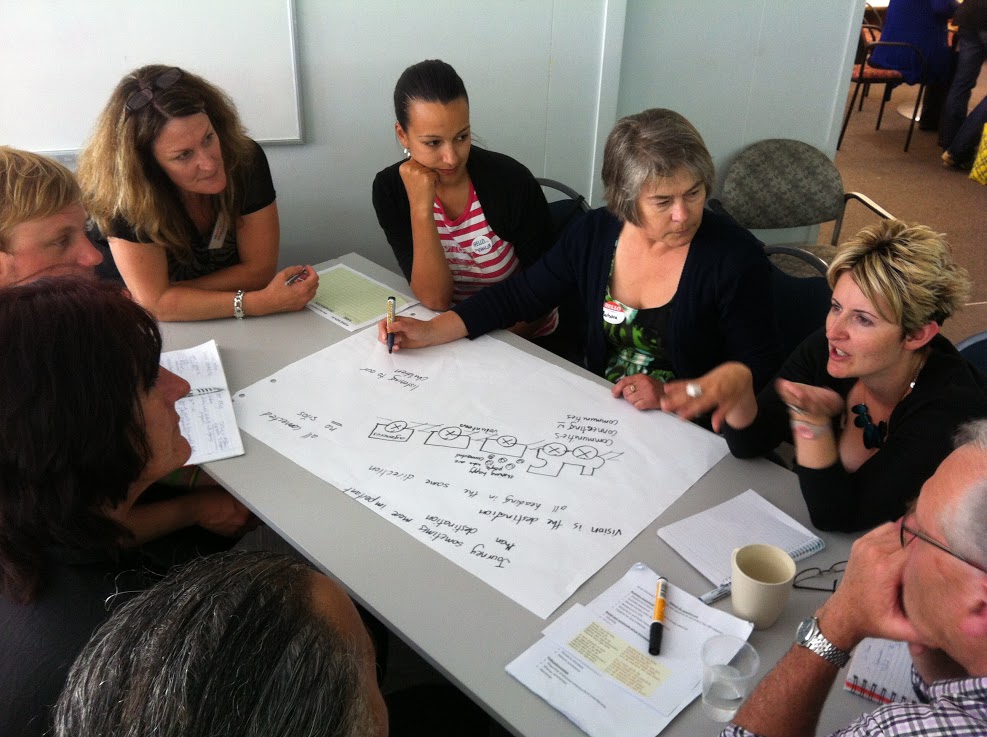
Shared wisdom comes from listening, noticing and making sense of the patterns that emerge over time
Ideas for developing your leadership capability:
What learning spaces are available in your CLD work for noticing, inquiring into and making sense of what’s working, what’s not, and why? Are these collective or individual spaces?
Is it safe to say “I don’t know that we are on the right track. Let’s stand back and reflect on this a bit more” in your community meetings?
Do people listen well to different perspectives to find new ways forward or do people more often argue to defend their own position?
What could you do to create better discussion and shared understanding?

